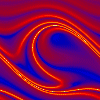

 |
|||
 |
|||
|
|
1. The Henon map Like the logistic map the Hénon system is a system with a discrete time scale n=1, 2, ... (i. e. it is a map). Whereas the logistic map maps a one-dimensional real interval [0..1] onto itself, the Hénon map is defined on the two-dimensional real plane. And whereas there is only one control parameter r in the logistic map, there are two control parameters a and b in the Hénon map:
Two fundamental characteristics of chaotic systems can be illustrated very well at the Hénon system. The first one is called sensitive dependence on the initial conditions. This causes systems having the same values of control parameters but slightly differing initial conditions to diverge exponentially (on the average) during their evolution in time. The second characteristic is called ergodicity . Ergodicity means that a large set of identical systems which only differ in their initial conditions will be distributed after a sufficient long time on the attractor exactly the same way as the series of iterations of one single system (for almost every initial conditions of this system).
The Hénon map is dissipative, i. e. a small volume in the state space (= a piece of the x,y-plane) is contracted by this map. Otherwise no attractor could arise. In order to proof this you can calculate the determinant of the Jacobian. This matrix reads:
So the determinant is -b. That means that a volume will be compressed by the factor |-b|, if b is smaller than 1. Other two-dimensional dissipative maps are for example the Ikeda map, the Kaplan-Yorke map, the Tinkerbell map or the Zaslavskij map.
2. Hénon´s quadratic twist map There is another two-dimensional map that has been investigated by M. Hénon and whose properties are totally different from the Hénon map, it is the quadratic twist map [Henon69]:
In the limit xn2 << yn this map just means rotation by the angle
has the determinant 1. Therefore no attractors exist for this map. Instead it exhibits the behaviour of Hamiltonian chaotic systems.
It can be easily checked using the applet that for suitable values of Literature Of course the Hénon system as well as the logistic map is a main topic in many textbooks, e.g. [Guckenheimer83 ] or [Schuster88]. It has been introduced and studied for the first time in [Henon76 ]. In [Feit78] the dependence of the largest lyapunov exponent on the control parameters has been studied. Herein you also will find diagrams of the basin of attraction. The stable and unstable manifolds of the Hénon system (and related systems) are treated in [ Franceschini81] and [Tel82]. How to find unstable periodic orbits in the Hénon-attractor is discussed in [Grassberger89]. For more details about the twist map see [Henon69] or [Lichtenberg83], e.g.
|
|
|
|
|
|
||||||||||||||||
| privacy statement |